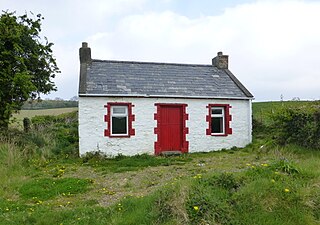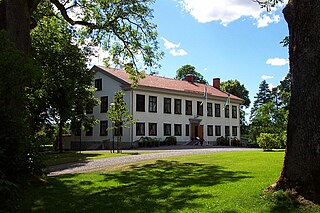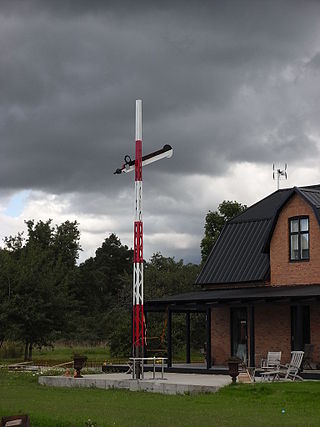Nordisk familjebok is a Swedish encyclopedia that was published in print from between 1876 and 1993, and that is now fully available in digital form via Project Runeberg at Linköping University. The public domain editions of the encyclopedia remain important reference works in Finland, especially on Finnish Wikipedia.

In Britain and Ireland, a workhouse was an institution where those unable to support themselves financially were offered accommodation and employment. In Scotland, they were usually known as poorhouses. The earliest known use of the term workhouse is from 1631, in an account by the mayor of Abingdon reporting that "we have erected wthn [sic] our borough a workhouse to set poorer people to work".

A cottage, during England's feudal period, was the holding by a cottager of a small house with enough garden to feed a family and in return for the cottage, the cottager had to provide some form of service to the manorial lord. However, in time cottage just became the general term for a small house. In modern usage, a cottage is usually a modest, often cosy dwelling, typically in a rural or semi-rural location and not necessarily in England. The cottage orné, often quite large and grand residences built by the nobility, dates back to a movement of "rustic" stylised cottages of the late 18th and early 19th century during the Romantic movement.

Karlskoga is a locality and the seat of Karlskoga Municipality, Sweden. Located within Örebro County, 45 km (28 mi) west of Örebro, and 10 km (6 mi) north of Degerfors. With a 2020 population of 27,386 distributed over 10.55 square miles (27.33 km2), Karlskoga is the second-largest city in both Örebro County and the historical province of Värmland.

A torp is a type of cottage emblematic of the Swedish countryside. It comes from the Old Norse þorp. In modern usage, it is the classic Swedish summer house, a small cottage painted in Falu red and white, and evidence of the way in which urbanization came quite late to all of Scandinavia. Its characteristic falu röd colour is ubiquitous in Sweden and became popular due to the paint's affordability. In the meaning of "simple second home", the concept exists under other names in Danish, Norwegian and Finnish.

Borgholm is a city and the seat of Borgholm Municipality, Kalmar County, Sweden with 4,401 inhabitants in 2020. It is located on the island of Öland in the Baltic Sea, at the Kalmar Strait-side of Öland, north of Färjestaden.

Elmesthorpe is a village and civil parish in the Blaby district of Leicestershire, England. It is situated to the south-east of Earl Shilton, near to Hinckley on the A47 road. In 2004, the parish had an estimated population of 520, reducing to 509 at the 2011 census.

Beeby is a village and civil parish in the Charnwood district of Leicestershire, England, with a population of 115 according to the 2011 census. It is situated north-east of Leicester, nearer to the villages of Keyham and Hungarton in the neighbouring district of Harborough and lies along the Barkby Brook. This small rural hamlet can be succinctly described as "a series of scattered houses that remain of the shrunken medieval village". The parish also includes the hamlet of Little Beeby, which consists of several houses within the settlement and is located 200m south east of the All Saints Church.

Cotter, cottier, cottar, Kosatter or Kötter is the German or Scots term for a peasant farmer. Cotters occupied cottages and cultivated small land lots. The word cotter is often employed to translate the cotarius recorded in the Domesday Book, a social class whose exact status has been the subject of some discussion among historians, and is still a matter of doubt. According to Domesday, the cotarii were comparatively few, numbering fewer than seven thousand people. They were scattered unevenly throughout England, located principally in the counties of Southern England. They either cultivated a small plot of land or worked on the holdings of the villani. Like the villani, among whom they were frequently classed, their economic condition may be described as free in relation to everyone except their lord.

Micklefield is a village and civil parish in the City of Leeds in West Yorkshire, England. It neighbours Garforth, Aberford and Brotherton and is close to the A1(M) motorway. The population as of the 2011 Census was 1,893, increased from 1,852 in 2001.

The Poor Relief Act 1601 was an Act of the Parliament of England. The Act for the Relief of the Poor 1601, popularly known as the Elizabethan Poor Law, the "43rd Elizabeth", or the "Old Poor Law", was passed in 1601 and created a poor law system for England and Wales.

Lokrume is a populated area, a socken, on the Swedish island of Gotland. It comprises the same area as the administrative Lokrume District, established on 1 January 2016.
The Icelandic census of 1703 was the first census of Iceland and the oldest complete census of any country that has survived. It was listed in UNESCO's Memory of the World Register in 2013.

Lojsta is a populated area, a socken, on the Swedish island of Gotland. It comprises the same area as the administrative Lojsta District, established on 1 January 2016.

Lau is a populated area, a socken, on the Swedish island of Gotland. It comprises the same area as the administrative Lau District, established on 1 January 2016. Originally an island, it is now part of the main Gotland island due to the isostasy. It is mostly known for the good water from the spring Lau Käldu.
A Backstugusittare is a historical term of a certain category of the country side population in the history of Sweden. It referred to the inhabitants of a backstuga, who lived on common land or the land of someone else and did not engage in any farming.
Rotegång or kringgång was a historical form of care for the poor in the history of Sweden to support the very poorest in the peasant community.
The Poor relief regulation of 1847 was a Swedish Poor Law which organized the public poor relief system in Sweden. With some alterations in 1853 and 1871, it established the basis for the poor relief system until the Poor Care Law of 1918 was passed.

Fardhem is a populated area, a socken, on the Swedish island of Gotland. It comprises the same area as the administrative Fardhem District, established on 1 January 2016. The area is rural with farms, tourism and small companies as the main sources of income. It is home to football club Fardhem IF.

Hablingbo is a populated area, a socken, on the Swedish island of Gotland. It comprises the same area as the administrative Hablingbo District, established on 1 January 2016.
















